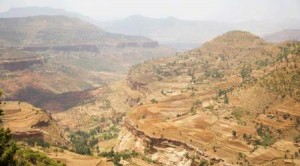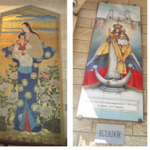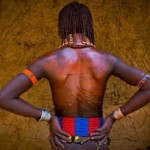After visiting with remote jungle tribes and taking in the dramatic landscapes of UNESCO-listed ancient cities and parks, Anisha Shah has lost her heart to Ethiopia
Her bottom lip was ceremoniously split at her coming of age. Now, here she stands, gracefully inserting a 13cm decorative clay plate into the fold; elegantly displaying her time-old traditions and mystical beauty of the Mursi tribeswomen.
The Mursi is a tribe of deep-set cultural roots, dwelling in small clans in southern Ethiopia’s isolated Omo Valley. The origins of their decorative traditions, I’m told, are aesthetic, though a counter-narrative suggests deliberate disfigurement to protect women from passing traders.
With a baby clutched to her breast, swarms of flies at her nipples and face streaked in ghostly white tribal paint, another topless Mursi emerges from a straw-capped tukul hut. Robed in multicoloured cloth, her shaved head is gracefully decorated with a string of bright, dried oranges. Protecting the clan are four tattooed tribesmen armed with Kalashnikovs. (A rifle-armed Omo ranger also accompanies me.) It’s a curious vision, perhaps the most surreal in a lifetime of travels. But it induces phenomenal respect.
South Ethiopia’s Tribal Culture
Invited into a villager’s tukul, the air is thick, redolent with plumes of smoke billowing from charcoal stoves. The native grain teff cooks to make spongy bread-like injera, upon which delicious stewed lentils are served.
The epicurean creation is consumed in a hearty sit-down meal on the very ground from which 90 percent of Ethiopia’s population survives. No visit to the birthplace of the coffee bean is also complete without an almost ceremonial approach to the Ethiopian brew. Beans are roasted, ground and brewed, producing a deliciously rich and intense cup.
Travelling alone through this remote, uncharted territory, where paved roads are few, distances vast and conveniences minimal, is certainly my greatest personal challenge. Yet every moment becomes a memory of a lifetime.
Only in the land considered the cradle of civilisation, where the headline-hitting skeleton of early mankind Lucy from 3.2 million years ago was discovered, can the cryptic web of millennia begin to unravel. Mentioned 47 times in the Bible, Ethiopia radiates an intriguing aura. To the open and inquisitive traveller, timeless tales of a land capped by ancient stone and UNESCO-heritage sites will be unearthed and ancient stories — in the form of art, inscription and architecture — will be revealed.
Off-roading solo in a Land Cruiser through the winding jungle path, deep into the unfurling expanse of exotic wildlife, we approach a large opening. It’s market day for the fantastical Hamer tribe and it’s heaving. Four tribes-girls run over, wide-eyed. They touch my hair and stroke my skin, conversing in melodic Amharic. “Konjo” is repeated at me. The guide translates: “You’re very beautiful”. Yet their conception of beauty may be regarded by outsiders as pure whimsy.
Draped in mass multicoloured beads and fur-lined leather hides, the girls’ breasts and backs are exposed. Backs proudly display scars of slashings that girls accept as precursor to marriage. Looking out and across the market into a sea of heads, I note an outlandish explosion of flame-red braids, thickly coated in a paste of red soil and butter. The ochre concoction seeps down foreheads and necks, melting beautifully into the contrasting dark skin. Hamer men, I realise, don a distinctly comical hairstyle of closely shaved heads with a centrepiece (resembling a furry microphone cover) atop their foreheads.
 Tribal culture here centres on timeless superstitions so firmly embedded it can prove overwhelming for a farangi (foreigner). Moving against advised distant observation, I beeline into the crowds, passing a gaggle of chatter like the breeze, and start to mingle.
Tribal culture here centres on timeless superstitions so firmly embedded it can prove overwhelming for a farangi (foreigner). Moving against advised distant observation, I beeline into the crowds, passing a gaggle of chatter like the breeze, and start to mingle.
Tobacco and khat (a stimulant from flowering plants native to the Horn of Africa), are on sale alongside vegetables and home ware. Inside compounds, rowdy clans are drinking — and insisting I try — their home-distilled spirit araki. I embarrassingly choke as the thick resin flames down my throat. Market morning is a captivating world of surreal sights. Personally, it’s made more incredulous by being alone in an other-worldly land, and without a tourist in sight.
North Ethiopia’s Ancient Civilisations
Dissected by the Great Rift Valley, the north is wildly contrasting, featuring the highest and lowest points in Africa. Abundant in archaeological, cultural and natural riches, this is the continent’s masked treasure.
Awakening at my hilltop lodge, I have an enviable view of a ferocious sunrise over Aksum, the historically pivotal former capital of the Axumite kingdom. Molten gold rays pour over the first-century-BC monolithic stone stelae and majestically uncover the world’s most mysterious UNESCO-designated land, where treasures and royal tombs square off against the elusive Ark of the Covenant. A dawn stroll through town unearths a mystical procession of thousands (an entire town, in fact) bedecked in white scarves and marching to church seemingly in a hypnotic state. Elders, with skin wrinkled as a walnut shell, clutch prayer beads deep in prayer as they make their way to the rather inconspicuous Chapel of The Tablet, which lays claims to the Ark of the Covenant, said to be held under guard.
After dark, Aksum’s alter ego emerges. Local house bars transform into cavalier Tigrigna dance floors, explosive in regional music and moves. After a few glasses of Ethiopian wine surrounded by haunting Amharic vocals, it’s impossible not to lose yourself to the city’s magnetic soul.
Mention Ethiopia to a non-traveller and the first word that escapes their lips is most likely “famine”, a misrepresented stereotype of a bygone time. But, mention Ethiopia to a traveller and chances are they’ll respond: “Lalibela” and with good reason. The magnificent UNESCO rock-hewn churches of Lalibela are a pilgrimage site and the country’s most recognisable landmark.
On approach, the 12th-century Bête Giyorgis (Church of St George, the patron saint of Ethiopia) comes into view. Carved out of the ground in the shape of a three-storey Greek cross — 15m below surface — the church is said to have been hewn with divine intervention from angels. Navigating its tiny canyon, steep narrow steps and rocky ledges is like a scene out of Indiana Jones. Inside, tiny cave altars are manned by traditionally robed Christian Orthodox priests bearing crosses.
Bête Giyorgis is one of the most finely executed and best preserved churches out of the 11 identified by UNESCO at Lalibela. Each boasts distinct architectural style, superbly crafted and laden with faded frescoes. Many house age-old religious manuscripts with ancient original inscriptions, the only traceable record of history.
For a contrasting setting, I fly into the UNESCO-designated Simien Mountains. A 600-million-year-old volcanic massif, it is one of the world’s most awe-inspiring destinations marked by deep gorges, undulating peaks and imposing walls of dazzling arid outcrops. Proudly rising out of the rocky plain is Ras Dashen, Ethiopia’s highest peak at 4,620m and Africa’s fourth-highest. A walk through its mountain meadows offer a glimpse at the world’s last grass-eating primate, the gelada monkey, known for their chest patch that resemble bright red “bleeding hearts”.
In the north-western Ethiopian Highlands, it’s the stillness of Lake Tana, the largest lake in Ethiopia and source of the Blue Nile, that’s captivating. Having boarded a private boat to sail the vast placid waters teeming with exotic birdlife — during which we watch a lone fisherman row his papyrus reed boat — we stop at miniscule shrub-shrouded islands, scattered like hidden jewels on the waters. The islands house churches from 13th-16th century that are embellished in vivid natural-colour frescoes and priceless manuscripts from the dawn of Christianity.
Longing for Ethiopia
Ethiopians have always been surrounded by sensory beauty. Rolling mountains gush red soil deep into wild rivers, tropical shores are tree-lined and jungle wildly tribal.
It’s easy to find time and space for isolation. Yet Ethiopians are sociable beings, with traditions of tribes and clans and free time spent at church. At night, villagers come together for evening meals under the stars. These elements of Ethiopia’s grace are key to explorations of the country.
It’s surprisingly safe yet intensely immersive. Ethiopia selflessly rewards travellers with unique perception-altering moments and all without any hint of tourists en masse. But with exciting plans to emerge as a world-class travel destination, I’d say get there before it’s discovered.
Reflection is powerful. One formidable moment sums up my adventure: Stopping the Jeep in a remote road to photograph a soiled jungle river, I find myself surrounded by village children. The 20-strong clan hold my hands, escorting me back towards my driver. He turns up the car stereo. As African beats resound into the jungle, we all start to dance, twirling, clapping and laughing aloud with no cares in the world. My heart remains abandoned in Ethiopia.
Where to Stay
Boutique lodges, all of them set against a beautifully untamed land, pepper the country
Southern Ethiopia
Aregash Lodge
Cocooned within Sidama’s famous coffee plantations, Aregash Lodge in Yirgalem overlooks endless mountains, lakes and waterfalls. Meals are prepared from the freshest ingredients — handpicked from acres of grounds — and enjoyed with the owner couple. aregashlodge.com
Simien Mountains
Simien Lodge
The highest hotel in Africa (at 3,260m), Simien Lodge is the best place to spot Gelada monkeys. Villas here are chameleons of nature, glistening in shades of rose, copper and auburn from dawn through dusk. Owner Nick Crane is often found hiking in surrounding hills or entertaining guests with infectious enthusiasm for the country. simiens.com
Lake Tana
Kuriftu Spa Resort
Situated on the shores of Lake Tana with sweeping views towards the water, the stone-built Kuriftu Spa Resort is a getaway in itself with a gourmet restaurant and extensive amenities including swimming pool, lounge areas, steam rooms and a day spa. kurifturesortspa.com
Anisha Shah, prestige-singapore.com






























Join Conversations